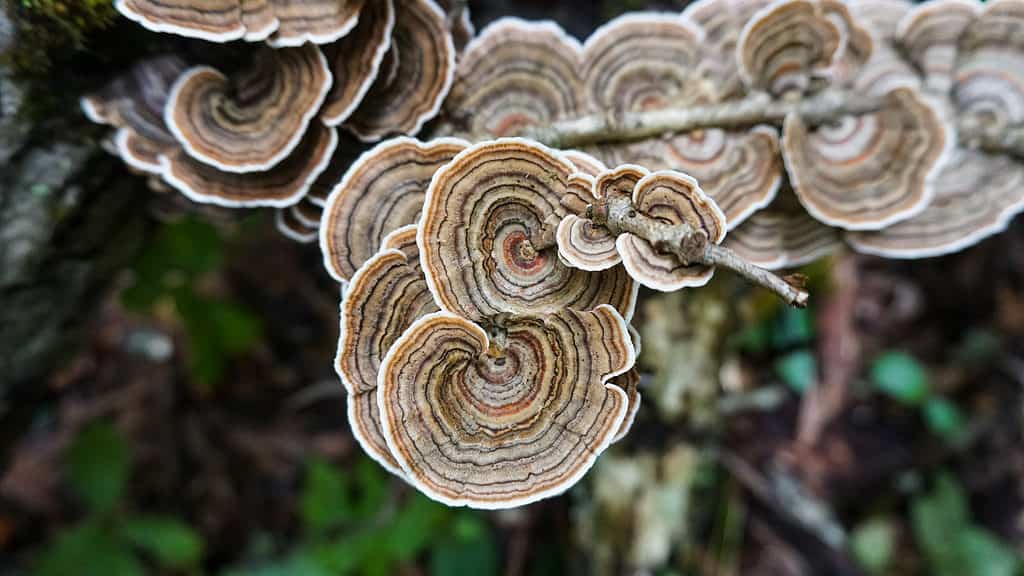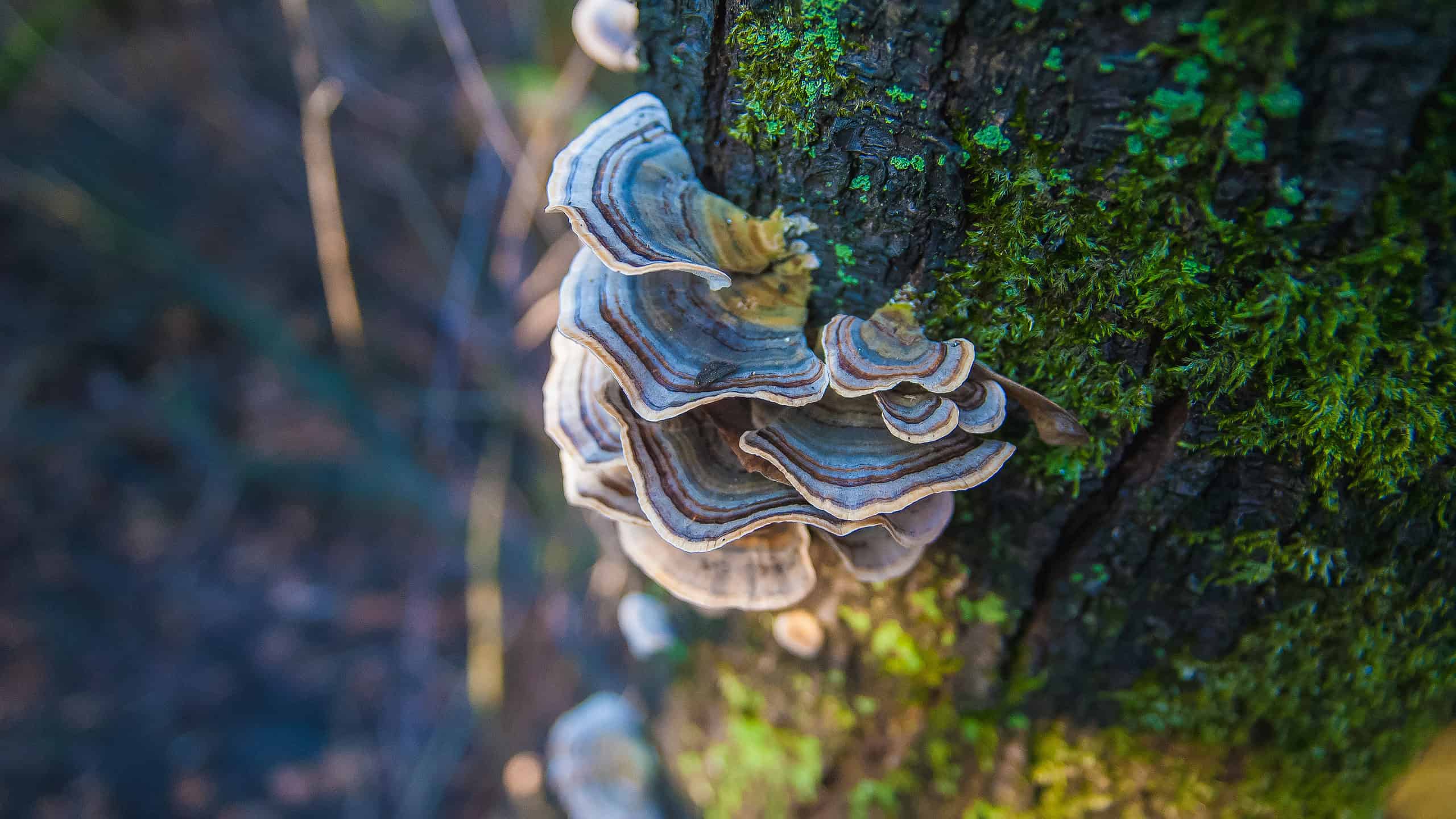Correct mushroom identification is the most important aspect of foraging for wild mushrooms. Of the more than 14,000 identified species of fungi worldwide, there are thousands of edible and medicinal mushroom varieties. In order to reap the benefits – and tasty flavors – of these mushrooms, we must be sure they are what we think they are. Today, we’re going to take a closer look at the turkey tail mushroom (Tramates versicolor) and the false turkey tail (Stereum ostrea). We’ll teach you about each mushroom and then we’ll offer helpful information on how to spot the difference.
Turkey Tail Mushroom (Tramates versicolor)

Turkey tail mushroom
(Tramates versicolor).
©Wirestock Creators/Shutterstock.com
The first thing that you need to know is where turkey tail grows. This is a very common mushroom in North American forests, and grows in nearly every state. Turkey tail also commonly grows in Asia and Europe. Turkey tail is a saprophyte. Saprophytes are a category of plants, fungus, and micro-organisms that feed on matter that is dying or dead. Saprophytes accelerate the decomposition of the matter they feed on. Turkey tail prefers hardwood trees, and grows on over 70 different tree species. This includes hickory, maple, oak, poplar, chestnut, birch, ash, aspen, and elm.
What’s in a Name?
Scientific names are an important part of mushroom identification. They are also very important in our observation of any species or subspecies in a genus, family, order, or class. Taxonomy helps us properly classify and identify the world around us. Sometimes, a scientific or taxonomic name changes. This is usually due to our advancement of knowledge about a species. Sometimes the name changes based on new discoveries causing us to reclassify. Other times, it is a realization that the species we are observing has already been adeptly classified. Why do we bring this up in an article comparing mushrooms/fungi? Well, the turkey tail has undergone a name change. We’d like to note that turkey tail was previously classified as Coriolus versicolor. Now, it is Tramates versicolor. You can use these names interchangeable, as Coriolus versicolor is still an accepted synonym of Tramates versicolor. If you wish to use the accepted scientific name of turkey tail, you’ll turn to Tramates versicolor.
Turkey Tail Identification
We identify mushrooms and fungi based on a variety of characteristics that they do or do not possess. What is the size and color of the cup? Does it have a stalk? What is the shape and size of the stalk? Does it have gills or pores? What are the traits of the gills or pores?
Turkey tail fungus does not possess a stalk. Instead, it is a concave cup that attaches itself directly to the tree or log it is growing from. Each of these cups measures up to four inches in width and is lined with concentric multicolored stripes. The stripes range in color, and include hues of red, yellow, green, blue, brown, black, and white. Small hairs – mostly invisible to the naked eye – cover the darker stripes of the fungus. Turkey tail is porous instead of gilled, and has a tough and leathery texture. The underside of the fungus is where pores are visible. Turkey tails are part of a group called “polypores”, which describes fungi with pores lining the underside of their cup. Polypores are rarely mushrooms but always fungi, and are an imperative part of nutrient cycling during the decomposition of plant matter.
Turkey tail does not grow alone. Instead, dense clusters of the fungus line stumps and logs in brackets of thin, tough leather. Here’s a basic identification checklist to help you correctly identify turkey tail.
- 1. The fungi should be flexible and thin, but leathery.
- 2. Turkey tail should be slightly velvet to the touch on the top side.
- 3. Concentric bands of several shades of color should cover the top side.
- 4. The fungi should have a porous, white underside.
False Turkey Tail (Stereum ostrea)

Extreme close-up of brown and green false turkey tail fungus growing on a dead tree limb in fall.
©Sheila Brown/iStock via Getty Images
False turkey tail is also called golden curtain crust. It deeply resembles true turkey tail but lacks some of the physical and medicinal features that turkey tail has. The good news is that it is not poisonous. Turkey tail has no poisonous lookalikes, so you’re not at risk of poisoning if you falsely identify your turkey tail. We still want to make sure that isn’t happening, so let’s dig a little deeper.
Like the turkey tail, Stereum ostrea is a saprophyte. It prefers decomposing oak trees, but it is happy to feed on other decaying hardwood trees. It leaves white deposits wherever it grows, which often resemble a coating of thin mold on the trees it decomposes. False turkey tail is more red in color, with colors including white, yellow, orange, brown, and red. Some false turkey tail is green in color, due to algae growth on the cap. False turkey tail sometimes displays these colors in concentric rings, but sometimes the fungi only has a couple of bands of color on it. Depending on the growth stage of this fungi, it can be very smooth or a bit hairy. The older the false turkey tail is, the smoother it becomes. It grows in clusters on the decaying logs, branches and stumps of deciduous trees. Each false turkey tail cap ranges in size from 1/2 of an inch in width to about 4 inches in width.
False turkey tail isn’t poisonous, but it is considered to be inedible. It is very tough and leathery and lacks enough medicinal or nutritional value to be worth consuming.
Fun fact: The scientific name of false turkey tail translates roughly to “tough oyster”.
How to Identify False Turkey Tail
It can be hard to tell the difference between turkey tail and false turkey tail. Both of these fungi possess concentric rings of color, grow on dead or dying hardwood, and grow in groups or clusters. However, there are still some easy ways to identify the difference.
- 1. Take a look at the bottom of the fungus. False turkey tail does not have any pores on it. Stereum ostrea is smooth on the bottom and sometimes accented with light wrinkles.
- 2. The underside of Stereum ostrea will be yellow or tan in color, versus the white coloration of the gilled underside of Tramates versicolor.
- 3. False turkey tail reaches widths of up to 5-7 cm.
- 4. Is red or brown in color, but sometimes orange.
Other Lookalikes
Stereum ostrea is not the only turkey tail lookalike. Since we are comparing two specific fungi, we will not launch into the characteristics of these other fungi. Instead, we have included a short list of turkey tail lookalikes. This list is not inclusive of all turkey tail lookalikes. Instead, it helps to highlight just a few fungi that are commonly mistaken for turkey tail.
- Hairy curtain bracket (Stereum hirsutum)
- Violet-toothed polypore (Trichaptum biforme)
- Smoky polypore (Bjerkandera adusta)
- Thin maze polypore (Daedaleopsis confragosa)
- Split gill (Schizophyllum commune)
- Steccherinum ochracceum
Most of these fungi are not considered to be edible, but some of them have medicinal value. For example, the hairy curtain bracket has some proven food antioxidant properties. Clinical tests have shows that when its mycelia is benzoate extracted, it has active antimicrobial effect against Staphylococcus aureus and Mycobacterium tuberculosis. This interesting fungus has also been used to help break down some endocrine disrupting compounds in waste plastics. It shares this ability with the true turkey tail, and they are both proven to be effective in helping to decontaminate lake sediment and toxicity in other bodies of water.
Summary and Identification Table

Turkey tail fungus (
Tramates versicolor)growing in the wild.
©James Aloysius Mahan V/Shutterstock.com
We’ve learned a lot today about two fascinating saprophytic fungi that grow commonly around the world. The most important takeaway, of course, is being able to tell the difference between the two fungi we have looked at. The easiest way to compare turkey tail and false turkey tail is to do a side-by-side comparison. For that reason, we will summarize what we learned using a helpful table that shows the key differences between these two polypores.
| Name | Size | Color | Shape | Texture |
|---|---|---|---|---|
| Turkey tail (Tramates versicolor) | 1-4 inches in width. | Concentric bands of red, yellow, green, blue, brown, black, and white. | Flat or concave with wavy edges that resemble the tails of turkeys. | Leathery and slightly velvety, with a porous underside. |
| False turkey tail (Stereum ostrea) | 1/2 inch to 4 inches. | Hues of white, yellow, orange, brown, and red. Sometimes coated green from algae growth. | Semi-circular and irregular. | Leathery and smooth or velvety, with a smooth or slightly wrinkled underside. |
From this table, it may seem tricky to deduce which is the real turkey tail and which is false. With enough patience and practice, you should easily be able to look at both fungi and know what they are pretty quickly. Again, it’s quite the boon that this particular situation is not one that risks your health or life. While consuming false turkey tail may be unhelpful – and even unpleasant due to the texture and flavor – you will be perfectly safe if you mix up these two species of incredible fungi.
The information presented on or through the Website is made available solely for general informational purposes. We do not warrant the accuracy, completeness, or usefulness of this information. Any reliance you place on such information is strictly at your own risk. We disclaim all liability and responsibility arising from any reliance placed on such materials by you or any other visitor to the Website, or by anyone who may be informed of any of its contents. None of the statements or claims on the Website should be taken as medical advice, health advice, or as confirmation that a plant, fungus, or other item is safe for consumption or will provide any health benefits. Anyone considering the health benefits of particular plant, fungus, or other item should first consult with a doctor or other medical professional. The statements made within this Website have not been evaluated by the Food and Drug Administration. These statements are not intended to diagnose, treat, cure or prevent any disease.
Thank you for reading! Have some feedback for us? Contact the AZ Animals editorial team.








